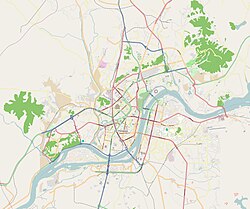 | |
| Location | Central District, Pyongyang, North Korea |
|---|---|
| Coordinates | 39°0′30″N 125°44′38″E / 39.00833°N 125.74389°E / 39.00833; 125.74389 |
| Type | Culture venue |
| Capacity | 120 (cinema), 600 (Yun Isang Music Hall) |
| Opened | 2 April 1988 (1988-04-02) |
| Pyongyang International House of Culture | |
| Chosŏn'gŭl | 평양국제문화회관 |
|---|---|
| Hancha | 平壤國際文化会館 |
| Revised Romanization | Pyeongyang Gukje Munhwa Hoegwan |
| McCune–Reischauer | P'yŏngyang Kukche Munhwa Hoegwan |
| External image | |
|---|---|
Pyongyang International House of Culture, also known as the Pyongyang International Cultural Center, is a cultural venue in the Central District of Pyongyang, the capital of North Korea. It was opened on 2 April 1988. It serves as venue for cultural exchange with foreigners.
Venue
Architecturally it combines Korean elements with Soviet architecture. It has a glass facade. The venue has ten floors and the floor space spans 10,000 square metres (110,000 sq ft).
Rooms dedicated to different cultural activities include art exhibitions, music practice and dance rooms, including a musical instrument room with 160 national instruments from all over the world. The building houses a cinema with the capacity of 120 seats and simultaneous interpreting capabilities. There is also a banquet hall, lounge, tea shop, and offices. The venue also houses the Songhwa Art Studio, and the Organizing Committee of the April Spring Friendship Art Festival.
It houses the Yun Isang Music Institute. The Yun Isang Music Hall, home of the Isang Yun Orchestra, is adjoined to the Pyongyang International House of Culture and houses further cultural facilities. It has a capacity of 600 seats.
The ground floor houses a permanent folkcraft exhibition with tradition Korean crafts by the Korea Minye General Corporation. Over 3,000 kinds of crafts, including Koryo celadon, are on display. Koryo Cultural Tourist Company is also based in the building.
See also
References
- ^ Corfield, Justin (15 July 2013). Historical Dictionary of Pyongyang. Anthem Press. p. 177. ISBN 978-0-85728-234-7.
- ^ Choe Kwang Hyok (2013). "Inheriting Folk Tradition". Pictorial KOREA (11): 26. ISSN 1727-9208.
- Pyongyang Review. Foreign Languages Publishing House. 1988. p. 96.
- Willoughby 2014, p. 115.
- ^ "Pyongyang International House of Culture". Naenara. 19 October 2015. Retrieved 21 October 2015.
- Willoughby 2014, p. 75.
- "April Spring Friendship Art Festival". Uriminzokkiri. Archived from the original on 14 July 2023. Retrieved 19 February 2019.
- "Past news". Korean Central News Agency. 1 July 1999. Archived from the original on 12 October 2014. Retrieved 21 October 2015.
- "Folkcraft exhibition". KCNA. 28 December 2001. Archived from the original on 12 October 2014. Retrieved 21 October 2015.
- "Folkcraft Showroom in Pyongyang International House of Culture". Naenara. Korea Pictorial. 2007. p. 2. Retrieved 21 October 2015.
- Maierbrugger, Arno (March 2014). Nordkorea: Geschichte, Kultur, Sehenswürdigkeiten. Trescher Verlag. p. 194. ISBN 978-3-89794-257-8.
Works cited
- Willoughby, Robert (22 July 2014). North Korea. Bradt Travel Guides. ISBN 978-1-84162-476-1.